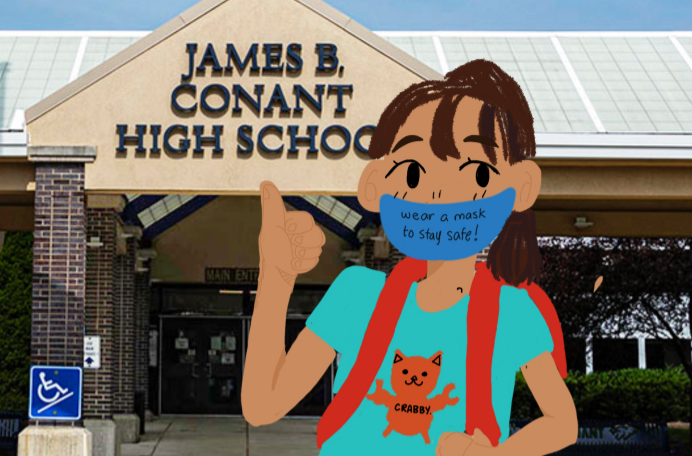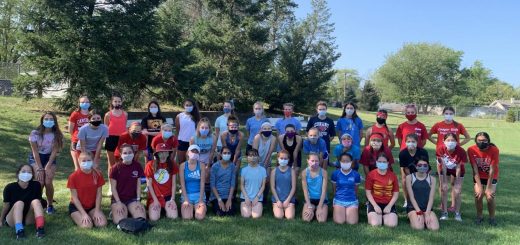The benefits of in-person learning outweigh the risks
 Amelie Pineda
Amelie Pineda Recently, Conant students have been starting to come into school and following the guidelines of the hybrid scenario. However, while some were eager to get out of their homes, many students have opted to stay at home in fear of the risks that come with the scenario.
The implementation of a hybrid scenario can result in a surge of COVID-19 cases among the Conant community. However, even amidst the pandemic, going back to school is crucial for the overall well-being of students.
Despite largely shared information that young people are carriers and spreaders of the disease, with proper social distancing and sanitizing, they are still continuously the least at risk. Going to school, for their demographic, wouldn’t be as risky considering their symptoms are much less severe than other groups or generations. According to the Center for Disease Control and Prevention, the positivity rate among teens from 12 to 17 years old has plateaued at about 7 percent. Moreover, the mortality rate has remained very low in kids, with less than a 0.1% mortality rate among kids ages 5 to 17.
Unless an individual has a weak immune system or other medical conditions, for most people, COVID is just a bad cold. There are instances where COVID can be much more brutal, like having extremely high fevers or having to go to the Emergency Room, but the experience is usually not deathly or intolerable. While this doesn’t mean the virus is completely harmless, it isn’t reasonable or realistic to isolate oneself until a vaccine or cure is found.
In fact, while one may think they are keeping themselves in optimal health by staying away from germs, their social and mental wellbeing may at the same time be suffering considerably.
According to a recent report from DuPage County, in the first six months of the year 2020, there has been an increase of 22.7% in suicides compared to the same time period in 2019. Moreover, according to the NCBI, with the build up of anxiety from COVID and depression from isolation, there has been a surge of mental illness among teens, a common one being anxiety. Many people are so concerned about the mortality rate from COVID, but what about the mortality rate from mental illnesses? For many students, the root of mental illnesses has been their home environment, and for others, it has been isolation. Going back to school is a chance to escape whatever students have been facing at home and interacting with people that aren’t siblings or parents.
Even a simple socially distant school day can be enough to clear one’s mind and improve one’s mental and social health. Although the hybrid plan’s requirement of social distancing doesn’t seem to allow many personal interactions, it could be refreshing to spend some time away from home and to get the chance to move around.
While we are fighting a pandemic, the threat of several other severe diseases has been creeping on us. Sure, COVID-19 is the current monster, but sooner or later, there will be a surge in other conditions because of something as simple as inactivity. As stated by Harvard Health, “Habitual inactivity raises risks for obesity, diabetes, cardiovascular disease, deep-vein thrombosis, and metabolic syndrome.”
More importantly, school is imperative to the social and emotional development of high school students. Through in-person classes, students learn life skills that can take them far during adulthood. Though commonly overlooked, in-person learning is just as important for socializing as it is for educational purposes.
Virtually learning over Zoom is also incredibly problematic and unproductive. Students constantly face internet disconnection and Zoom glitches, and that’s only one part of the problem. Mackenzie Medema, ‘24, said, “I have had some internet issues, and so has the rest of my family. It affects me with the loss of instruction time because then I get lost and don’t understand what we’re doing.”
Students also lack working spaces that are suitable for efficient learning, which is disruptive to their education. How can someone stay focused on their schoolwork if they don’t have anywhere to learn besides their beds or couches? Falling asleep or procrastinating is pretty much inevitable at that point. At the District 211 Board Meeting on September 17, D211 parent Robi Vollkomer said, “My own son was laying in bed during class, and when I confronted him about it, he said he was in PE class.”
Furthermore, the presence of COVID can possibly be permanent- does that mean we will never go back to school ever again? We must find ways to move on from our paranoia and progress in our lives. Of course, this doesn’t mean we shouldn’t ignore safety guidelines or refuse to wear masks, but it just isn’t reasonable to wait for a vaccine or cure to start to get outside and see real people.
Nonetheless, deciding whether or not you want to go to school is based solely on the individual. If you feel like you are putting your life in danger, or if you or family members are susceptible to the virus, stay home and stay safe.




Recent Comments